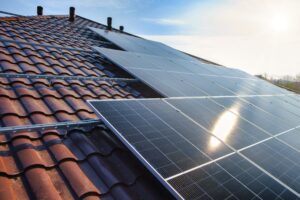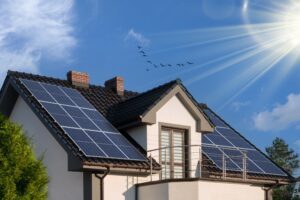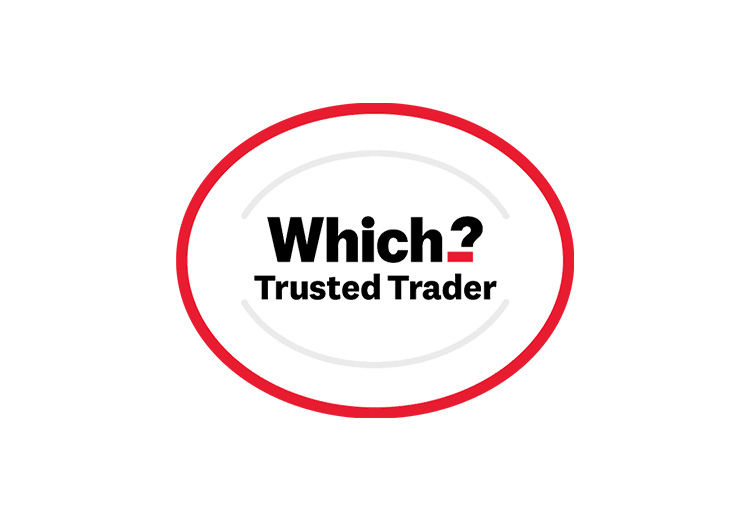Our experienced team of solar panel installers can help mobile homeowners save hundreds of pounds in electricity bills by making full use of solar panel technology.
- Average savings of £450 including SEG.
- Energy independence from the national grid.
We offer portable solar panels for mobile homes of all kinds, from house trailers with limited roof space to park homes similar in size to a regular household. Contact us today, and take advantage of affordable solar panels, courtesy of the limited-time 0% VAT exemption.
Solar power is becoming the new standard.
As of November 2024, around 1.4 million homes, or 5% of all UK households, have solar panels installed. This is an increase of 1.5% from 2022, and trends show that it will only continue to increase by the end of 2025. While these metrics apply mostly to standard residential homes, a portion of the adoption belongs to mobile homes—most of which are park homes on licensed sites.
We would argue that installing solar panels for mobile homes can be more beneficial than installing them in a standard home, with immediate returns in energy efficiency. A 2 kW solar photovoltaic panel system is often used as a standard for park homes, for example, and these homeowners use between 50% and 80% of all solar energy generated to power all of their needs within the home. Your portable home will experience maximum energy independence and flattened bills immediately.
How much can you save with mobile home solar power?
Mobile homeowners powered through the national grid generate an estimated 2,400 – 3,000 kWh of electricity per year. At an average rate of 30p per kWh, this runs up energy costs of around £720 to £900 per year.
Assuming you’re installing a 2 kW solar panel system, mobile homeowners can enjoy green energy generation of between 1,600 and 1,800 kWh per year, around 2/3rds of the annual average.
The following is a breakdown of the savings.
- £250 to £350 w/ solar panels – By using immediate solar power generation during daylight hours, you can offset between £250 to £350 from your annual energy bills.
- £350 to £450 w/ solar and SEG – SEG stands for Smart Export Guarantee, and it is the process of selling excess green energy that you won’t use back to the national grid. You can technically make more than these parameters depending on your rates, but the most commonly applied is between 5p and 7p per kWh.
- £500 to £600+ w/ solar and battery – The only way to maximise your savings and reach total energy independence from the national grid is to buy a battery. With a battery, any energy you don’t use is stored rather than sold. This means that on days you’re not at your mobile home, you will have green energy to come back to. Average savings with a battery will reach £500 to £600, but it’s possible depending on use to reach a zero-sum energy bill.
What Solar Packages Can I Get?
The solar packages that are suitable for your mobile home revolve around how much space you have on your rooftop. The two most common choices are:
- Grid-tied starter pack—The most common type is a 2 kW grid-tied Array. It features 6 – 8 panels, a 2 kW single-phase inverter, and lightweight railings as a mounting system. It can generate between 1,600 and 1,800 kWh per year. Grid-tied systems can take advantage of SEG, selling your excess energy to add to your savings or make a profit if you are otherwise filled.
- A grid-tied system with battery—The second most common is a 2-3 kW grid-tied system that comes with a small or large battery. It has 6 – 10 panels, 1,600 to 2,400 kWh, and a battery that can hold between 1 – 10 kWh of energy. The larger the capacity, the larger the battery—something worth noting for smaller mobile homes.
Effective Home can help you, whether you want to add solar panels to a mobile home or add a solar battery to an existing solar setup panels are currently at their cheapest thanks to Effective’s £500 discount and the government’s 0% VAT exemption, but beware the latter is only in effect until March 2027. Reduce your electricity costs and carbon footprint by contacting us for a free quote.
Solar Panels for Mobile Homes – FAQs
What are mobile homes?
In the UK, mobile homes describe a category of homes that can be moved. They do not necessarily need wheels, but their foundation can be uprooted so the home can be moved elsewhere. The maximum dimensions of a mobile home are:
- Length – 20 meters
- Width – 6.7 meters
- Internal ceiling height – 3.05 meters
Common examples of mobile homes include:
- Touring caravan – Towable by car, often used for holidays or short-term stays. They are small and designed to be hooked up to campsite power, but can be off-grid with a small solar panel.
- Motorhome/Campervan – Built on a vehicle chassis with an engine that is self-propelled. They are often used with a leisure battery that can be topped up via a small, roof-mounted solar panel.
- Static caravan – A larger and less permanent structure. They are often located in holiday parks and can be used year-round if the park license allows it.
- Park homes—Park homes are the more common type of mobile home. They resemble bungalows with detachable foundations, and their roof space allows for a larger number of solar panels.
How many solar panels are required to run a static mobile home?
Different types of mobile homes will require different levels of coverage. Keep in mind that without a battery to store the energy you don’t use, having day-round access to energy is unlikely unless you don’t use electricity outside of daylight hours.
The following is a breakdown of what you will need per type of mobile home:
| Mobile Home Type | Typical Annual Usage | Efficiency Adjustment | System Size for Near-100% Coverage | Estimated Number of Solar Panels (~300–450) W each) |
| Touring Caravan | ~300–500 kWh | ~345 – 575 kwh | 0.3–0.5 kW | 1–2 solar panels |
| Motorhome | ~500–800 kWh | ~575 – 920 kwh | 0.5–0.8 kW | 2–3 solar panels |
| Static Caravan | ~2,400–3,000 kWh | ~2,760 – 3,450 kwh | 2–3 kW | 5–10 solar panels |
| Park Home | ~2,400–4,000 kWh
(year-round occupancy) |
~2,760 – 4,600 kwh | 3–4 kW | 7–14 solar panels |
How do I calculate the optimal number of solar panels needed for my mobile home’s energy consumption?
Most mobile homeowners require a 3-4 kW solar power system to fulfil their daily needs.
Our team of solar experts can help you come up with the optimal range through our free quote service. However, if you want guidance in calculating how much you’ll require to self-inform your buying choice, the following is how:
- Determine your mobile home’s energy usage – Check your electricity bills to find an average, and divide the monthly kWh by 30 (for 30 days). This will determine your daily kWh requirement.
- Breakdown—Your electricity consumption will be listed clearly on your electricity bill, either monthly or quarterly. Whatever the kWh listed, divide it by the number of days in the cycle, which will either be 28-31 or 90-92 days.
- Adjust for efficiency (usually 15%) – Add 15% to your required daily kWh sum. This is to adjust for efficiency, as solar panels run at between 85% to 100% efficiency.
- Calculate solar panel wattage: Divide daily energy usage (plus 15%) by peak sun hours to get the number of solar panels you will need. Since you can’t have a partial solar panel, round it up to the nearest whole number.
- Breakdown – It’s best to calculate how much you need by incorporating the 3 – 5 hours of peak sun hours into the equation for consistency. Multiply the wattage of each panel (usually 300 to 450 W) by 5. For example, if your park home requires 7.59 kWh a day (+15% included), you would need 4 400w solar panels to generate enough energy to cover the whole day.
- Decide on a battery – Your solar power will peak during sunlight hours and without a battery, that energy will either: be immediately consumed by your home or sold via SEG. Batteries allow you to store energy, which is much more valuable when stored versus when sold. This also allows you to generate backup energy for when your park home will experience prolonged or higher levels of energy use.
When installing solar panels using this calculation method, understand that best practices show that adding one or two on top of the required amount of panels to account for season changes or other unexpected circumstances.
What are the best solar panels for mobile homes?
Mobile homes are named as such for their ability to be moved or relocated. This means you need to ensure the following factors in your chosen solar panels:
- Lightweight – Your roof may not be as strong as the standard residential property so the panels may need to be more lightweight..
- High-efficiency solar power – To maximise energy generation on limited roof space, you should opt for higher efficiency, higher-watt output solar panels.
- Durable – If the solar panels will experience travel, harsh weather conditions or vibrations, you should opt for a type of solar panel that will withstand all of it.
- Easy to install – Solar panel types, such as portable solar panels, will require a more straightforward installation to minimise the need for structural changes.
How much is the labour for installing solar panels?
Installation costs of solar panels range between £500 to £1,500. This is, of course, not including the cost of the solar panels themselves.
The costs of components such as the mounting system are usually included in the fee in itemised form, and miscellaneous items such as the wiring come with the solar panel itself.
Inverters and batteries are both to be bought on their own and usually don’t incur extra costs.
What building regulations and planning permission needs to be met for mobile home solar panels?
Installing solar panels requires adherence to the following building regulations:
- Structural safety (Part A) – This confirms the mobile home is structurally safe, being able to support the additional weight of solar panels.
- Electrical safety (Part P) – Electrical work has to comply with UK electrical safety standards.
- Fire safety (Part B) – The installation shouldn’t obstruct fire escape routes or create fire hazards.
Ensuring the installation of your solar PV systems is done by a professional will cover all of these bases.
As for planning permission, many solar power systems are considered within the parameters of “permitted development”, meaning express permission is not required. However, take the following into account:
- Protrusion limits – For pitched roofs, solar panels shouldn’t protrude for more than 200mm from the roof surface. For flat roofs, protrusion is limited to 600mm.
- Height restrictions – Panels must not extend above the highest part of your roof.
- Designated areas – If your mobile home is located within a conservation area, or is part of a regulated list of areas/buildings, the additional restrictions that apply may require you to get planning permission.
How do I calculate the payback period for solar panels installed on mobile homes?
The payback period denotes the period you require to generate enough savings in solar power to make a return on your investment. You can calculate this by taking the total cost of your system and dividing it by the projected range of your annual savings, adding SEG income to make the final sum more accurate. The number that you get back will determine the amount of years you’ll require to make a return on your investment.
The following table will provide an example:
| System Size (kW) | Approx. Total Cost (GBP) | Estimated Annual Savings (GBP) | SEG Income (GBP/year) | Projected Payback (Years) |
| 2 kW | £3,000–£4,000 | £200–£300 | £30–£50 | 10–15 |
| 3 kW | £4,000–£5,000 | £300–£400 | £40–£60 | 10–14 |
| 4 kW | £5,000–£6,000 | £400–£500 | £50–£70 | 9–13 |
Can installing solar panels increase the property value of your mobile home?
Yes, solar panels can boost a mobile home’s resale value. The reason is their ability to reduce electricity demand from the grid, thereby cutting your energy bills as you’ll be a lot more energy self-sufficient. This is highly appealing on the property market, as lower running costs directly impact value.
Your property will increase in value if:
- Significant production and savings – If your solar power generation is strong enough to power most, if not all, of your mobile home’s needs, this will be a positive selling point. The increase in value will only be legitimised when you can prove the solar panels are equipped with a code-compliant system with clear warranties and maintenance records.
- Battery storage – Having a battery expands your solar power usage flexibility, thereby further decreasing electricity consumption, making your property more desirable.
- Permanent fixture – Mobile homes that are not permanently affixed to a piece of land you own are not classified as “real property”, meaning they cannot be recognised in mortgage financing, formal appraisals and property valuations.
How can I tell whether or not the roof of my mobile home can support the weight of solar panels?
Solar panels can come in various shapes and sizes that determine how much they weigh. A typical 300 W monocrystalline panel weighs between 18-20 kg per panel. The average mobile home needs at least 4 kWh per day to meet half of their daily needs, which is around 4 panels.
To quantify the strength of your roof, you need to know the rated load capacity, which is how much weight the roof can bear while meeting safety standards. It is measured in kg/m2 (square metres). For example, if your park home has a rated load of 75 kilograms per square metre, then your roof can hold 75 kg for every square metre you have. Concentrated weight can cause roof damage, but solar panels spread the weight through their mounting system.
Take this into account, as well as any possible rain or snowfall that will add to the overall roof weight. A moderate to heavy snowpack in some UK regions can reach up to 30kg per square metre. Although it’s not a common occurrence, these weather conditions only need to add to the overall pressure once to incur damage.
The only way to find out your roof load rating is to have a professional estimate this for you. That being said, the average roof loads across different mobile home types are as follows:
- Touring caravan – Approximately 40kg to 50kg per square metre, being lightweight to accommodate towing.
- Travel trailer – Approximately 30kg to 40kg per square metre, often featuring collapsible roofs and light framing.
















